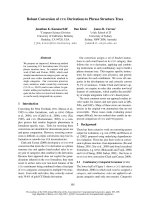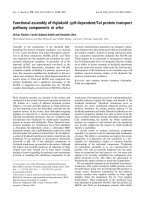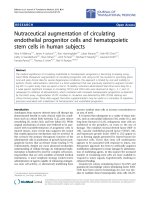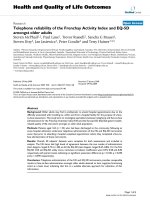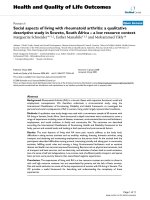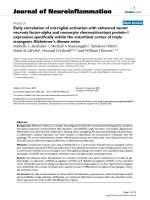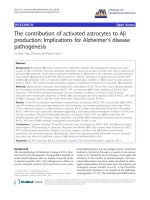Báo cáo hóa học: " Confined conversion of CuS nanowires to CuO nanotubes by annealing-induced diffusion in nanochannels" ppt
Bạn đang xem bản rút gọn của tài liệu. Xem và tải ngay bản đầy đủ của tài liệu tại đây (1.13 MB, 6 trang )
NANO EXPRESS Open Access
Confined conversion of CuS nanowires to CuO
nanotubes by annealing-induced diffusion in
nanochannels
Cheng Mu, Junhui He
*
Abstract
Copper oxide (CuO) nanotubes were successfully converted from CuS nanowires embedded in anodic aluminum
oxide (AAO) template by annealing-induced diffusion in a confined tube-type space. The spreading of CuO and
formation of CuO layer on the nanochannel surface of AAO, and the confinement offered by AAO nanochannels
play a key role in the formation of CuO nano tubes.
Introduction
Well-aligned semiconductor one-dimensional (1D)
nanost ructures have attracted extensi ve attention in the
last decade owing to their great potential in novel
optoelectronic nanodevices, such as laser diodes, field
effect transistors, light-emitting diodes, and sensors [1].
Copper oxide (CuO) is a p -type semiconductor with a
narrow band gap, and is a candidate material for photo-
thermal and photocon ductive applications [ 2,3]. More-
over, it is potentially a useful component in the
fabrication of s ensors, field emitters, lithium-CuO elec-
trochemical cells, cathode materials, and high Tc-super-
conductors [4,5]. Its crystallinity, size, and shape and
stoichiometry play a key role in these applications. Con-
siderable efforts have been devoted to overcoming
numerous challenges associated with efficient, controlled
fabricat ion of these nanostructures via chemi cal or phy-
sical approaches. Thus far, well-aligned 1 D CuO nanos-
tructures have been obtained using techniques such as
thermal evaporation [2,6], electro spinning [7], MOCVD
[8], and sol-gel process [9]. CuO nanowires were also
prepared by conversion from their nanoscale analogs of
copper hydroxide at elevated temperatures [ 10-14]. In
this study, a novel approach for the preparation of C uO
nanotubes via confined conversion from CuS nanowires
by annealing-induced diffusion in nanochannels is
reported.
Recently, prior studies including these of the authors
have reported the preparation of metal sulfide nanowires
by chemical precipitation in anodic aluminum oxide
(AAO) channels under ambient conditions [15,16]. In
this article, the authors report on the synthesis of CuO
nanotubes using CuS nanowires embedded in AAO as
precursor. Not only the structure but also the morphol-
ogy of p roduct could be selectively controlled via this
method. The conversion too was easily performed. This
approach may be extended to the synthesis of various
metal oxide nanotubes by annealing their precursor
nanowires embedded in AAO template, and the precur-
sor can be sulfides, carbonates, and oxalates, which can
be readily transformed into oxides at elevated
temperatures.
Experimental section
Preparation
AAO templates used were prepared by aluminum ano-
dic oxidation as described previously [17]. In brief, elec-
tropolished aluminum foil was anodized in aqueous
oxalic acid (4%) at a constant voltage of 40 V for several
hours to prepare AAO templates of 50-nm pores using
a H-type cell. After t he anodization, the remaining alu-
minu m was etched by a 20% HCl + 0.2 M CuCl
2
mixe d
solution, and the barrier layer was dissolved by 5% phos-
phoric acid.
In a typical synthesis of CuS nanowires, one half-cell
of the H-type cell was filled with aqueous (NH
4
)
2
Sof
* Correspondence:
Functional Nanomaterials Laboratory and Key Laboratory of Photochemical
Conversion and Optoelectronic Materials, Technical Institute of Physics and
Chemistry, Chinese Academy of Sciences, Zhongguancun Beiyitiao 2,
Haidianqu, Beijing 100190, China
Mu and He Nanoscale Research Letters 2011, 6:150
/>© 2011 Mu and He; licensee Springer. This is an Open Access article distributed under the terms of the Creative Commons Attribution
License ( which permits unrestricted use, distribution, and reproduction in any medium,
provided the original work is properly cited.
0.01 M, and the other was filled with aqueous CuSO
4
of
stoichiometric concentration. After reaction for 12 h,
the AAO template embedded with CuS nanowires were
detached and thoroughly washed with deionized water
and subsequently annealed in muffle furnace in air at
650°C for 1-20 h.
Materials characterization
Crystallographic and purity information on as-prepared
metal sulfide nanowires were obtained using powder
X-ray diffraction (XRD). The XRD analyses were per-
formed using a Philip X’Pert PRO SUPER çA rotation
anode with Ni-filtered Cu Ka radiation (l = 1.5418 Å).
Identical slit width and accelerating voltage were used
for all the samples.
CuS nanowires and CuO nanotubes were observed on
a field emission scanning electron microscopy (SEM)
instrument (FE-SEM Leo 1550) operated at an accelera-
tion voltage of 10 kV. The CuS nanowires and CuO
nanotubes were recovered by dissolving the AAO mem-
brane in 2 M aqueous NaOH for 2 h at r oom tempera-
ture. The products were obtained by centrifugation
followed by washing three times with deionized water
and dried in air. Samples were dropped onto silicon
wafer which was ultimately attached onto the surface of
SEM specimen stage. For the analysis of nanowire
arrays, membranes were initially attached to a piece of
silicon wafer by conductive double-sided carbon tape.
They were immersed in 0.2 M aqueous NaOH for 1 h
in order to partially remove the template, creating
aligned nanowires/nanotubes. After washing with deio-
nized water followed by air-drying, the specimens were
subsequently mounted onto a SEM specimen stage for
imaging.
Specimens for transmission electron microscopy
(TEM) and high-resolution TEM (HRTEM) observations
were prepared by dropping the as-prepared nanowires/
nanotubes onto carbon-coated copper grids followe d by
drying. TEM images and selected area electron diffrac-
tion (SAED) patterns were obtained on a JEO L JEM-
2100 TEM, and HRTEM images were obtained on a
JEOL JEM-2100F TEM.
Results and discussion
The purity a nd crystallinity of as-prepa red CuS nano-
wires and CuO nanotubes were chara cterized by XRD
measurements before removing the AAO membrane.
Figure 1 shows XRD patterns collected in t he 2-theta
range of 20-70° for the samples of both CuS nanowire
and CuO nanotube. All the peaks in Figure 1a could be
ascribed to hexagonal CuS (cell constants a =3.796Å,
c = 16.38 Å; JCPDS Card No. 78-0876). The only strong
XRD peak in Figure 1a indicates that the CuS nanowires
have preferred (110) orientation, and all the peaks in
Figure 1b could be readily indexed as monoclinic CuO
(cell constants a =4.6Å,b =3.4Å,c =5.1Å;JCPDS
Card No. 80-1917).
The size and morphology of the as-synthesized CuS
nanowire and CuO nanotube we re examined by SEM.
Figure 2 shows SEM images of the as-prepared CuS
nanowires and CuO nanotubes. Figure 2a is a typical
SEM of CuS nanowires which were prepared using an
AAOtemplatewithaporesizeassmallas50nm.The
nanowires are straight, and uniform in size along th eir
axial direction. Their diameters are in the range of 50
± 5 nm, which agree well with those of the pores of
the AAO template used, indicating fine confinement of
the template pores. Figure 2b gives a SEM top view of
the CuS nanowire array after partly dissolving the
AAO pore wall. The nanowires tend to “ stick” to each
other due to capillary force. Figure 2c is a typical SEM
image of CuO nanotubes. It presents a large number
of nanotubes without any visible byproducts, suggest-
ing that the product is of high purity. Th e nanotube
diameter ranges from 50 to 60 nm. Their surfaces are
not quite smooth. Figure 2d shows a top view of CuO
nanotube array, clearly showing the open-ends of the
nanotubes.
The morphology of the CuO nanotubes was further
confirmed by TEM ob servations. Figure 3a is a typical
TEM image of the CuS nanowire, indicating that the
nanowire possesses a smooth surface and a uniform dia-
meter of ca. 50 nm that is again in good agreement with
that of the AAO pore. The inset of Figure 3a shows the
SAED spots of CuS nanowire, a nd could be well
assigned to the hexagonal crystal system, in agreement
withtheaboveXRDresults.Thecleardistribution
of spots indicates the single crystal nature of the
CuS nanowire. The HRTEM image of CuS nanowire
(Figure 3b) with clearly visible lattice fringes also pro-
vides the evidence of single-crystal nature. A typical
TEM image of the CuO nanotube is shown in Figure 3c.
The inner/outer surfaces of the CuO nanotube were not
quite smooth as compared to the CuS nanowire, and its
diameter was estimated to be ca. 55 nm, which is larger
than that of the CuS nanowire. The SAED analysis on
the CuO nanotube gave a clear electron diffraction pat-
tern (the inset of Figure 3c) composed of several rings.
At least three diffraction rings could be identified, with
average d spacings of 2.53 and 2.52 Å associated with
the 002 and -111 reflec tions, 2.32 an d 2.31 Å associated
with the 111 and 200 reflections, and 1.87 Å associated
with the -202 reflection. The SAED results, in accor-
dance with the XRD data, demonstrate that the CuO
nanotube is polycrystalline of the monoclinic phase, and
has lost the preferred orientation. The HRTEM image of
CuO nanotube shown in Figure 3d further identifies a
polycrystalline structure.
Mu and He Nanoscale Research Letters 2011, 6:150
/>Page 2 of 6
20 30 40 50 60 7
0
Intensity
2
(
de
g
ree
)
(110)
(002)
(111)
(202)
(020)
(202)
(113)
(311)
(220)
(100)
(110)
A
B
Figure 1 XRD patterns of as-prepared CuS nanowires (a) and CuO nanotubes (b) using AAO template with 50-nm pores.
1 μm
1 μm
C
500 nm
B
D
500 nm
A
Figure 2 Typical SEM images of CuS nanowires. (a); array (b); CuO nanotubes (c); and array (d) fabricated using AAO template with 50-nm
pores.
Mu and He Nanoscale Research Letters 2011, 6:150
/>Page 3 of 6
A hypothesis for the formation mechanism of CuO
nanotubes from CuS nanowires was that, at elevated
temperature, CuO was formed by oxidation of CuS, and
might be spread on the pore surface of AAO t emplat e.
ItwaspreviouslyreportedthatCuOcouldforma
monolayer spontaneously on the Al
2
O
3
surface at a tem-
perature much lower than its melting point [18,19].
Once a CuO layer is formed o n the pore surface of
AAO template, further spreading of CuO would become
possible, which would eventual ly result in the formation
of CuO nanotubes. To examine this hypothesis for the
formation mechanism of CuO nanotubes, CuS nano-
wires embedded in AAO template were annealed in
muffle furnace at 650°C for varying periods of time.
Figure 4a,b,c,d shows TEM images of CuO nanostr uc-
tures obtained by annealing CuS nanowires embedded
in AAO f or 1, 4, 10, and 20 h, respectively. After 1-h
annealing, the CuS nanowires o f smooth surface were
converted to CuO nanowires of rough surface, which
consist of small aggregated CuO particles. This is in
sharp contrast to the single crystal structure of precur-
sor CuS nanowires. After annealing for 4-20 h, the CuS
nanowires turned to tube-type CuO nanostructures. The
wall thickness of tube-type CuO nanostructure became
thinner with increase of annealing time, and for
extended annealing (e.g., 20 h), the exterior surface of
AAOtemplatewasfoundtobecoveredbyathinCuO
layer. This clearly indicated that CuO had spread on the
channel surface and exterior surface of AAO template.
Figure 4e schematically illustrates the process of CuO
nanotube growth. In contrast, nanowires without the
support of AAO template would break under different
heat-treatment conditions, leading to the formation of
nanoparticles instead of nanotubes [20,21]. Thus, the
spreading of CuO and formation of CuO layer on the
nanochannel surface of AAO and the confinement
offered by AAO nanochannels play a key role in the for-
mation of CuO nanotubes. While the surface CuO layer
acts as a nucleation center, the AAO nanochannels help
the CuO nanowires maintain their 1 D morpholo gy at
elevated temperatures.
Conclusions
In summary, CuO nanotubes were successfully con-
verted from CuS nanowires embedded in AAO template
by annealing-induced diffusion in a confined tube-type
D
5 nm
C
50 nm
A
50 nm
B
5 nm
Figure 3 TEM images of a single CuS nanowire. (a) and CuO nanotube (c) with a diameter of 50 nm. The insets in (a, c) are the electron
diffraction patterns of the CuS nanowire and CuO nanotube. HRTEM images of CuS nanowire (b), and CuO nanotube (d).
Mu and He Nanoscale Research Letters 2011, 6:150
/>Page 4 of 6
space. The spreading of CuO and formation of CuO
layer on the nanochannel surface of AAO and the con-
finement offered by AAO nanochannels play a key role
in the formation of CuO n anotubes. Preliminary results
showed that the present conversion by annealing-
induced confined diffusion of sulfide nanowires to oxide
nanotubes might be readily extended to other precursors
that can thermally deco mpose to form corresponding
oxides, including carbonates and oxa lates, and thus
opening up a new viable r oute to prepare nanotubes of
various oxides. Since the CuO nanotubes grew with the
assistance of AAO template, their diameter and pore
size could be feasibly tuned by changing the electro che-
mical parameters used during the fabrication of the
A
B
C
D
CuO
Al
2
O
3
E
Figure 4 TEM images of CuO nanowires and nanotubes obtained by annealing at 650°C for varying periods of time: (a) 1h,(b) 4h,(c)
10 h, and (d) 20 h. The scale bars in (a-d) are 20 nm. (e) Schematic illustration of the growth process of CuO nanotubes.
Mu and He Nanoscale Research Letters 2011, 6:150
/>Page 5 of 6
AAO template. It is expected that such CuO nanotubes
may offer exciting opportunities for applications in cata-
lysis, electrochemistry, superconductivity, and super-
hydrophobic coating. Furthermore, CuO nanotubes with
large specific surface areas may also be applied in sensor
applications.
Abbreviations
AAO: anodic aluminum oxide; CuO: copper oxide; HRTEM: high-resolution
TEM; SAED: selected area electron diffraction; SEM: scanning electron
microscopy; TEM: transmission electron microscopy; XRD: X-ray diffraction.
Acknowledgements
This study was supported by NSFC (Grant No. 21003142) and the Knowledge
Innovation Program of the Chinese Academy of Sciences (CAS) (Grant No.
KSCX2-YW-G-059).
Authors’ contributions
CM designed the experiments, carried out the sample preparation,
performed SEM, TEM, HRTEM and XRD measurements and drafted the
manuscript. JH coordinated the research fund and activity and helped
design the experiments. Both authors took part in the discussion of the
results and helped shape the final manuscript. All authors read and
approved the final manuscript.
Competing interests
The authors declare that they have no competing interests.
Received: 2 September 2010 Accepted: 16 February 2011
Published: 16 February 2011
References
1. Xia YN, Yang PD, Sun YG, Wu YY, Mayers B, Gates B, Yin YD, Kim F, Yan HQ:
“One-dimensional nanostructures: Synthesis, characterization, and
applications”. Adv Mater 2003, 15:353.
2. Jiang XC, Herricks T, Xia YN: “ CuO nanowires can be synthesized by
heating copper substrates in air”. Nano Lett 2002, 2:1333.
3. Musa AO, Akomolafe T, Carter MJ: “ Production of cuprous oxide, a solar
cell material, by thermal oxidation and a study of its physical and
electrical properties”. J Sol Energy Mater Sol Cells 1998, 51:305.
4. Lanza F, Feduzi R, Fuger J: “Effects of lithium oxide on the electrical
properties of CuO at low temperatures”. J Mater Res 1990, 5:1739.
5. Podhajecky P, Zabransky Z, Novak P, Dobiasova Z, Eerny R, Valvoda V:
“Relation between Crystallographic Microstructure and Electrochemical
Properties of CuO for Lithium Cells”. ElectrochimActa 1990, 35:245.
6. Cheng CL, Ma YR, Chou MH, Huang CY, Yeh V, Wu SY: “Direct observation
of short-circuit diffusion during the formation of a single cupric oxide
nanowire”. Nanotechnology 2007, 18:245604.
7. Wu H, Lin DD, Pan W: “Fabrication, assembly, and electrical
characterization of CuO nanofibers”. Appl Phys Lett 2006, 89:133125.
8. Malandrino G, Finocchiaro ST, Nigro RL, Bongiorno C, Spinella C, Fragalà IL:
“Free-standing copper(II) oxide nanotube arrays through an MOCVD
template process”. Chem Mater 2004, 16:5559.
9. Su YK, Shen CM, Yang HT, Li HL, Gao HJ: “Controlled synthesis of highly
ordered CuO nanowire arrays by template-based sol-gel route”. Trans
Nonferrous Met Soc China 2007, 17:783.
10. Cao MH, Hu CW, Wang YH, Guo Y, Guo CX, Wang EB: “A controllable
synthetic route to Cu, Cu2O, and CuO nanotubes and nanorods”. Chem
Commun 2003, 1884.
11. Du GH, Tendeloo GV: “Cu(OH)2 nanowires, CuO nanowires and CuO
nanobelts”. Chem Phys Lett 2004, 393:64.
12. Lu CH, Qi LM, Yang JH, Zhang DY, Wu NZ, Ma JM: “Simple template-free
solution route for the controlled synthesis of Cu(OH)(2) and CuO
nanostructures”. J Phys Chem B 2004, 108:17825.
13. Wen XG, Xie YT, Choi CL, Wan KC, Li XY, Yang SH: “Copper-based
nanowire materials: Templated syntheses, characterizations, and
applications”. Langmuir 2005, 21:4729.
14. Zhang WX, Ding SX, Yang ZH, Liu AP, Qian YT, Tang SP, Yang SH: “Growth
of novel nanostructured copper oxide (CuO) films on copper foil”. J Cryst
Growth 2006, 291:479.
15. Mu C, He JH: “Synthesis of Single Crystal Metal Sulfide Nanowires and
Nanowire Arrays by Chemical Precipitation in Templates”. J Nanosci
Nanotechnol 2010, 10:8191.
16. Zhang F, Wong SS: “Controlled Synthesis of Semiconducting Metal
Sulfide Nanowires”. Chem Mater 2009, 21:4541.
17. Mu C, Yu YX, Wang RM, Wu K, Xu DS, Guo GL: “Uniform metal nanotube
arrays by multistep template replication and electrodeposition”. Adv
Mater 2004, 16:1550.
18. Xie YC, Tang YQ: “Spontaneous monolayer dispersion of oxides and salts
onto surfaces of dupports: Applications to heterogeneous catalysis”. Adv
Catal 1990, 37:1.
19. Wang F, Wang Y, Yu JF, Xie YC, Li JL, Wu K: “Template-assisted
preparations of crystalline Mo and Cu nanonets”. J Phys Chem C 2008,
112:13121.
20. Wang SH, Huang QJ, Wen XG, Li XY, Yang SH: “Thermal oxidation of Cu2 S
nanowires: A template method for the fabrication of mesoscopic CuxO(x
= 1,2) wires”.
Phys Chem Chem Phys 2002, 4:3425.
21. Ahmad T, Ramanujachary KV, Lofland SE, Ganguli AK: “Nanorods of
manganese oxalate: a single source precursor to different manganese
oxide nanoparticles (MnO, Mn2O3, Mn3O4)”. J Mater Chem 2004, 14:3406.
doi:10.1186/1556-276X-6-150
Cite this article as: Mu and He: Confined conversion of CuS nanowires
to CuO nanotubes by annealing-induced diffusion in nanochannels.
Nanoscale Research Letters 2011 6:150.
Submit your manuscript to a
journal and benefi t from:
7 Convenient online submission
7 Rigorous peer review
7 Immediate publication on acceptance
7 Open access: articles freely available online
7 High visibility within the fi eld
7 Retaining the copyright to your article
Submit your next manuscript at 7 springeropen.com
Mu and He Nanoscale Research Letters 2011, 6:150
/>Page 6 of 6
